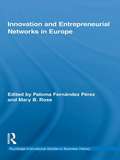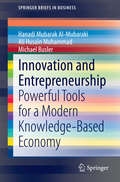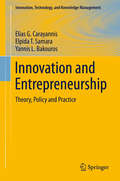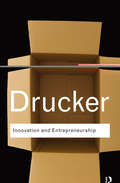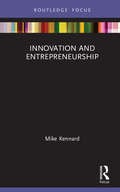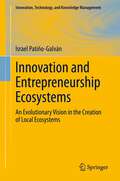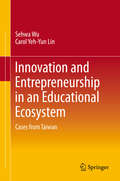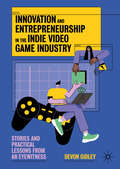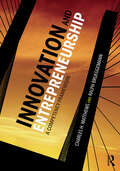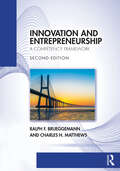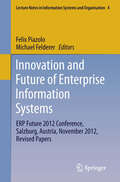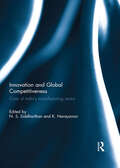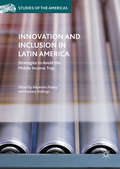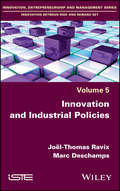- Table View
- List View
Innovation and Economic Crisis: Lessons and Prospects from the Economic Downturn (Routledge Studies In Global Competition Ser. #53)
by Daniele Archibugi Andrea FilippettiThe recent financial and economic crisis has spurred a lot of interest among scholars and public audience. Strangely enough, the impact of the crisis on innovation has been largely underestimated. This books can be regarded as a complementary reading for those interested in the effect of the crisis with a particular focus on Europe.
Innovation and Economic Development (Routledge Studies in the Economics of Innovation)
by Raja M. Almarzoqi F. John MathisOver the past two decades, several sudden, unforeseen, and significant changes have occurred in the world's political and economic landscape. This book explores their impact on the processes of contemporary disruptive innovations during the Fourth Industrial Technology Revolution and the role that global finance and international commerce play. The expansion of multinational corporations, increasing dependence on global supply chains, and the globalization of the world economy have aided the rising expansion of Innovations worldwide.The authors analyze the drivers and relationship between these increasingly dispersed Innovations and the expanding linkage between economic growth in developed and developing countries. Progress will continue with technological innovations in financial services, lowering the cost to consumers and companies. Financial transactions will be executed increasingly by the individual using their cell phone or computer. Electronic digital payments and banking will replace currency.This book focuses on Innovations in advanced countries and examines developments in emerging markets and the implications for the world's future economic growth. The collaborative expansion and dispersion of online education across different cultures impact labor markets, diversity and immigration, and the rise and expansion of women entrepreneurial Innovators. The progression of global access to higher levels of education is changing the culture, values, and institutional foundations supporting Innovation.Knowledge of the expanding Innovation Ecosystems is crucial for understanding contemporary global business and entrepreneurship, international trade and capital flows, and investments impacting world history and economic, social, and political sciences subjects.
Innovation and Entrepreneurial Networks in Europe (Routledge International Studies in Business History)
by Mary Rose Fernández Pérez PalomaThe entrepreneur is involved in the dance of two questions – what is needed and what is possible. The interplay of these two questions is an ongoing process and innovation varies internationally and regionally, depending on differing legal and policy systems, variations in the development of education and skill development, in social processes and in knowledge transfer. This book explores innovation and networks in entrepreneurship with an interdisciplinary approach, focusing on how old and new knowledge can be combined to produce radical innovation. These chapters combine themes of entrepreneurship, innovation and networks with a specifically European focus, highlighting the wide variations at the national, regional and business level. These variations suggest the need to break with traditional stereotypes about Southern and Northern Europe. The book takes a Schumpeterian perspective, emphasising the importance of looking at the history of entrepreneurship and innovation, paying particular attention to the neglected area of innovation in services within firms.
Innovation and Entrepreneurship
by Hanadi Mubarak Al-Mubaraki Ali Husain Muhammad Michael BuslerIn this book, Hanadi Mubarak, Ali Husain and Michael promote the concept of innovation incubators from a business-management perspective. The book provides a comprehensive roadmap for the development of new economies based on technology, as well as value added in technology transfer, innovation development and an entrepreneurial climate. Many books on innovation and entrepreneurship take a theoretical approach, presenting a selection of examples that may not reflect reality. However, this compendium of innovation and entrepreneurship case studies is based on the practical experience of executives and managers regarding the undertaking of projects within their industry and company. It is this practical approach, emphasizing enterprise-wide projects as a consequence of the current economic reality that differentiates this book from conventional texts on innovation and entrepreneurship. This investigation uses successful international case studies based on models in developed and developing countries. It argues that innovation incubators must be adopted by Arab countries to support diversification of their economies, the commercialization of new technologies, job creation and foster an entrepreneurial climate. The book presents research and case studies, which provide new insights into practices for undertaking projects that both executive and project managers will find interesting and useful for the advancement of their enterprises, particularly in the area of innovation and entrepreneurship.
Innovation and Entrepreneurship
by Elias G. Carayannis Elpida T. Samara Yannis L. BakourosThis book aims to meet the needs of education and training in modern techniques of innovation and entrepreneurship, and focuses on the detailed presentation of successful business practices. As today's global economic landscape is changing rapidly, the ability of businesses to introduce new products and services to the market faster than their competitors is perhaps their most distinct competitive advantage. This becomes obvious by the significant market share that the most innovative companies gain while increasing profitability. Extensive research in this field has demonstrated that companies that are constantly innovating normally double their profits compared to others. Moreover, establishing successful practices and policies of innovation management, through which ideas evolve from conception through evaluation to implementation and commercialization, become the basis for economic growth at the firm, industry, national, regional, and global levels. Taking Greece as an example, this volume identifies systemic weaknesses in development of new products, risk capital, patenting, broadband penetration, lifelong training, investment in research on the part of firms, high-tech exports, and employment in medium-high-technology manufacturing that place the country at the bottom of the European Union in economic performance and threaten its potential to achieve sustainable growth. To address these weaknesses in Greece and similar countries around the world, the authors present a comprehensive overview of the principles of innovation and entrepreneurship, with particular respect to their relationships to knowledge, learning, and creativity. Drawing from a strong theoretical foundation, and illustrated through in-depth case studies and examples from both private and public sectors, the authors present a framework for innovation management that integrates research, education, practical application, and policy. Specific topics include technology transfer, intellectual property rights management, the practice of knowledge management intellectual capital investment, business incubators, and Cooperation Research and Development Agreements (CRADAs).
Innovation and Entrepreneurship
by Peter DruckerInnovation and entrepreneurship are discussed under three main headings: The Practice of Innovation; The Practice of Entrepreneurship; and Entrepreneurial Strategies. Each of these is an "aspect" of innovation and entrepreneurship rather than a stage. This is a practical book, but it is not a "how-to" book. Instead, it deals with the what, when, and why; with such tangibles as policies and decisions; opportunities and risks; structures and strategies; staffing, compensation, and rewards.
Innovation and Entrepreneurship
by Peter DruckerHow can management be developed to create the greatest wealth for society as a whole? This is the question Peter Drucker sets out to answer in Innovation and Entrepreneurship. A brilliant, mould-breaking attack on management orthodoxy it is one of Drucker’s most important books, offering an excellent overview of some of his main ideas. He argues that what defines an entrepreneur is their attitude to change: ‘the entrepreneur always searches for change, responds to it and exploits it as an opportunity’. To exploit change, according to Drucker, is to innovate.? Stressing the importance of low-tech entrepreneurship, the challenge of balancing technological possibilities with limited resources, and the organisation as a learning organism, he concludes with a vision of an entrepreneurial society where individuals increasingly take responsibility for their own learning and careers. With a new foreword by Joseph Maciariello
Innovation and Entrepreneurship
by Peter F. DruckerPeter Drucker's classic book on innovation and entrepreneurship This is the first book to present innovation and entrepreneurship as a purposeful and systematic discipline that explains and analyzes the challenges and opportunities of America's new entrepreneurial economy. Superbly practical, Innovation and Entrepreneurship explains what established businesses, public service institutions, and new ventures need to know and do to succeed in today's economy.
Innovation and Entrepreneurship (Management Practice Essentials)
by Mike KennardThe effective management of innovation and entrepreneurship is vitally important for managers, organisations and governments. This concise textbook examines strategic approaches and concepts relevant for the effective management of innovation and entrepreneurship, supported by practical insights from a variety of industry sectors. The book: • Identifies the key challenges and dilemmas faced by managers and executives charged with leading, stimulating and sustaining innovation within large complex organisations. • Explores the critical factors that drive entrepreneurial venture creation and growth, including the search for opportunities, the management of risk and the evaluation of alternative funding sources. • Considers how innovation and entrepreneurship can be facilitated through the development of technology, knowledge, intellectual property and networks. Each chapter includes an essential summary of the key points, a practical example focusing on innovation and entrepreneurship in action, discussion and reflection activities, as well as further reading suggestions. Innovation and Entrepreneurship provides a practical and concise introduction for executive education students studying MSc and MBA apprenticeship programmes, as well as supplementary reading for postgraduate students studying modules on Innovation and Entrepreneurship.
Innovation and Entrepreneurship Ecosystems: An Evolutionary Vision in the Creation of Local Ecosystems (Innovation, Technology, and Knowledge Management)
by Israel Patiño-GalvánThis book offers an alternative framework for the creation and evolution of local innovation and entrepreneurship ecosystems in which the central and operational role is led by the university through an Entity that Operates the Ecosystem (EOE). It explains how the university, industry and government actors interact to create ecosystems and how said ecosystems promote the growth and development of local start-ups. It provides researchers, scholars, academics and practitioners with a guide to the construction of innovation and entrepreneurship ecosystems and offers tools to assist in the creation of enterprises from entrepreneurial ideas.
Innovation and Entrepreneurship Education in China: Responding to Social Change (Education in the Asia-Pacific Region: Issues, Concerns and Prospects #60)
by Xiaozhou XuThis book explains the strategic appeal of innovation and entrepreneurship education based on the systematic analysis of the key characteristics and constraints of China’s economic transformation and upgrading. The book presents results related to studying the common trends of innovation and entrepreneurship education at the times of economic globalization and the experience of major countries, exploring the cultivation model of key innovation and entrepreneurship talents and mechanism of the innovation and entrepreneurship education ecosystem. Based on ecology and system theory, this book puts forward the concept of “global ecology” to explain the complex relationship among various elements in the process of innovation and entrepreneurship education.
Innovation and Entrepreneurship in an Educational Ecosystem: Cases from Taiwan
by Carol Yeh-Yun Lin Sehwa WuThis book reports on 12 education innovation cases in Taiwan and focus particularly on an ecosystem to demonstrate innovation as a competitive advantage and requires an ecosystem to be sustainable in virtually all disciplines. It also covers the trend of education innovation in many countries, with “education entrepreneurship” being the frequently used description. The 12 educators highlighted here are even more entrepreneurial than many businesspeople. Generally, schools are required to follow certain rules, especially the public schools. Accordingly, the book also describes how these education entrepreneurs have innovatively created a fostering environment under challenging constraints to facilitate the success of students, teachers, and even the local community. Six of the cases involve school-based innovation, while the other six focus on student-based innovation. Their stories provide valuable insights for all companies seeking to become more innovative in a resource-constrained setting.
Innovation and Entrepreneurship in the Indie Video Game Industry: Stories and Practical Lessons from an Eyewitness
by Devon GidleyThe indie video game industry attracts an enormous amount of enthusiasm and curiosity, blending cutting edge tech, a creative industries environment and a certain rebellious energy. It is idealised as a world where creative and technical ability is given free reign and can yield enormous financial and reputational rewards. But what is it really like to enter and work in this space? And how do the universal aspects of organisation, including teamwork, leadership and competition, manifest in this unique environment? By embedding himself in just such a hub, the author was able to explore the experiences and interactions of ten indie game companies, four mentors, various funders, and two interns over a one-year period. The narrative is structured around six critical events: the introduction of newcomers, change in organizational rules, departure of a dominant social actor, self-inflicted crisis, introduction of a powerful manager, and external crisis. A process view shows how these events can hinder or accelerate creative production. Going beyond success stories or failure statistics, this book analyses the organizational and entrepreneurial strength of this approach, which combines aspects of the incubator and accelerator models for start-up development. At its heart though, this book attempts to give a fleshed out and analytical picture of what it is really like to work in the indie video game industry and offers practical lessons for indie-game developers.
Innovation and Entrepreneurship: A Competency Framework
by Charles H. Matthews Ralph BrueggemannThis book presents a new model, the competency framework, for students, innovators, entrepreneurs, managers, and anyone who wants to better understand the dynamic world of innovation and entrepreneurship. Focused on both the individual and strategic organizational level, this book is about people and the competencies each person needs to learn to be successful in creating a more dynamic future. Matthews and Brueggemann’s framework for innovation and entrepreneurship competencies empowers individuals to excel at innovation and new venture creation. It provides a practical guide and clear and concise understanding of the knowledge, skills, attitudes, and experiences that are needed to increase imagination, creativity, innovation and new venture creation capability. Innovation and Entrepreneurship will be attractive for students of entrepreneurship, innovation, management and cross-disciplinary classes, such as design thinking. Presented in a modular format, Innovation & Entrepreneurship informs the future direction of people and technology, as well as the educational systems producing the next generation of innovators and entrepreneurs. Based on extensive academic research, this book is organized into two sections: Twelve innovation elements and twelve competency categories. The elements are the foundation and the competency categories are the building blocks that inform our path toward a more precise understanding of how innovation and entrepreneurship plays an important role in economic development and our daily lives.
Innovation and Entrepreneurship: A Competency Framework
by Charles H. Matthews Ralph F. BrueggemannThis book presents a new model, the competency framework, for students, innovators, entrepreneurs, managers, and anyone who wants to better understand the dynamic world of innovation and entrepreneurship.Focused on both the individual and strategic organizational level, this book is about people and the competencies each person needs to learn to be successful in creating a more dynamic future. The framework for innovation and entrepreneurship competencies empowers individuals to excel at innovation and new venture creation.It provides a practical guide and clear and concise understanding of the knowledge, skills, attitudes, and experiences that are needed to increase imagination, creativity, innovation, and new venture creation capability. Innovation and Entrepreneurship will be attractive for students of entrepreneurship, innovation, management, and cross-disciplinary classes, such as design thinking.Presented in a modular format, Innovation and Entrepreneurship informs the future direction of people and technology, as well as the educational systems producing the next generation of innovators and entrepreneurs.Based on extensive academic research, this book is organized into two sections: 12 innovation elements and 12 competency categories. The elements are the foundation and the competency categories are the building blocks that inform our path toward a more precise understanding of how innovation and entrepreneurship play an important role in economic development and our daily lives.
Innovation and Export: The Joint Challenge of the Small Company
by Manon EnjolrasThe concepts of innovation and export are traditionally considered in isolation, both within companies and within the support organizations dedicated to them. As a result, within this broad research field, very little academic work has focused on how to implement their relationship at an operational level. This book proposes a joint diagnostic tool for SMEs, highlighting good practices to be mastered in order to simultaneously improve innovation and export performance, in the form of a virtuous circle. Innovation and Export focuses on the integration of innovation and export into the strategic management of SMEs, for which the use of synergies is a powerful lever to overcome any difficulties in mobilizing significant resources.
Innovation and Finance: Demand, Finance, Organization, Policy And Innovation In A Schumpeterian Perspective (Routledge/Lisbon Civic Forum Studies in Innovation)
by Andreas Pyka Hans-Peter BurghofInnovation and finance are in a symbiotic and twin-track relationship: a well-functioning financial system spurs innovation by identifying and funding stimulating entrepreneurial activities which trigger economic growth. Innovations also open up profitable opportunities for the financial system. These mutual dynamics cause and need innovative adaptations in the financial system in order to better deal with the changing requirements of a knowledge-based economy. The volume comprises different contributions which focus on the central imperative of this evident connection between financial markets and innovation which, despite its importance, is only barely considered in academia, as well in practice so far. The book is about the mutual interdependence of innovation processes and finance. This interdependent relationship is characterized by a high degree of complexity which stems, on the one hand, from the truly uncertain character of innovation and, on the other hand, from the different time scales in both domains. Whereas innovation processes are long-term and experimental, financial markets are interested in shortening time horizons in order to optimize financial investments. Economies which do not manage to align the two realms of their economic system are in danger of ending up in either financial bubbles or economic stagnation. The chapters of this book deal with different aspects of this complex interrelationship between innovation and finance, highlighting, for example the role of stock markets, venture capital and international financial transactions, as well as the historical co-development of the financial and industrial domains. Thus far, the communities in economics dealing with both issues are almost completely disconnected. The book brings together economic research dealing with the interface between innovation and finance and highlights the importance of the Neo-Schumpeterian perspective. This topic is of particular interest in the current economic crisis affecting the Eurozone and its currency. Most of the policy instruments discussed and implemented so far are focused on short-run targets. This discussion of the relationship between innovation and finance suggests a long-run perspective to create new potentials for economic growth and a sustainable way out of the economic crisis.
Innovation and Future of Enterprise Information Systems: ERP Future 2012 Conference, Salzburg, Austria, November 2012, Revised Papers
by Michael Felderer Felix PiazoloThis volume presents the revised and peer reviewed contributions of the "ERP Future 2012" conference held in Salzburg/Austria on November 11th - 12th, 2012 . The conference is a platform for research in ERP systems and closely related topics like business processes, business intelligence, and enterprise information systems in general. To master the challenges of ERP comprehensively, the ERP Future 2012 Research conference accepted contributions both with a business focus as well as with an IT focus to consider enterprise resource planning from various viewpoints. This combination of business and IT aspects is a unique characteristic of the conference and of this volume that resulted in valuable contributions with high practical impact.
Innovation and Global Competitiveness: Case of India's Manufacturing Sector
by N. S. Siddharthan and K. NarayananIn the post-liberalization period, India has slowly but steadily tried to foster innovation to improve competitive efficiency of Indian manufacturing and thus boost global competitiveness of the industrial sector. Foreign direct investment was looked upon as a major source of technology paradigm shift; in recent times, industrial firms have been investing overseas, even in countries to which they used to export, based on their technological capabilities. Firms in Indian manufacturing industries have also attempted to bring about technological upgrades through imports of design and drawings (disembodied technology) against lump sum, royalty and technical knowhow fees, and imports of capital machinery (embodied technology) where the technology is embodied in the capital good itself.This volume comprises empirical contributions on this emerging phenomenon, on a range of issues including the role of R&D; mergers, acquisitions and technological efforts; technological determinants of competitive advantages; the role of small and medium enterprises and regional patterns; technological efforts and global operations; and the role of industrial clusters in promoting innovation and competitiveness.This book was originally published as a special issue of Innovation and Development.
Innovation and Incentives
by Suzanne ScotchmerInterest in intellectual property and other institutions that promote innovation exploded during the 1990s. Innovation and Incentives provides a clear and wide-ranging introduction to the economics of innovation, suitable for teaching at both the advanced undergraduate and graduate levels. It will also be useful to legal and economics professionals. Written by an expert on intellectual property and industrial organization, the book achieves a balanced mix of institutional details, examples, and theory. Analytical, empirical, or institutional factors can be given different emphases at different levels of study. Innovation and Incentives presents the historical, legal, and institutional contexts in which innovation takes place. After a historical overview of the institutions that support innovation, ranging from ancient history through today's government funding and hybrid institutions, the book discusses knowledge as a public good, the economic design of intellectual property, different models of cumulative innovation, the relation of competition to licensing and joint ventures, patent and copyright enforcement and litigation, private/public funding relationships, patent values and the return on R&D investment, intellectual property issues arising from direct and indirect network externalities, and globalization. The text presents technical and abstract analysis and at the same time sheds light on current controversies and policy-relevant topics, including the difficulty of enforcing copyright in the digital age and international protection of intellectual property.
Innovation and Inclusion in Latin America
by Alejandro Foxley Barbara StallingsThis book argues that Latin America must confront two main challenges: greater innovation to increase productivity, and greater inclusion to incorporate more of the population into the benefits of economic growth. These two tasks are interrelated, and both require greater institutional capacity to facilitate both innovation and inclusion. Most countries in Latin America are struggling to escape what economists label "the middle income trap. " While much if not all of the region has emerged from low income status, neither growth nor productivity has increased sufficiently to enable Latin America to narrow the gap separating it from the world's most developed economies. Although income inequality has diminished across much of the region in recent years, social vulnerability remains widespread and institutional weaknesses continue to plague efforts to achieve equitable development. This volume identifies lessons that can be learned and adapted from experiences within the region and in East Asia, where the middle income trap has largely been avoided. This book is the result of a collaborative project undertaken by American University's Center for Latin American & Latino Studies (CLALS) and the Corporation for Latin American Studies (CIEPLAN) in Chile, with financial support from the Inter-American Development Bank's Office of Strategic Planning and Development Effectiveness.
Innovation and Industrial Development in China: A Schumpeterian Perspective on China’s Economic Transformation (Routledge Frontiers of Business Management)
by Kaidong FengThis book focuses on China's economic transformation at firm and institution levels. It shares insights into the growth of innovative Chinese firms in the automobile and telecom equipment sectors, both of which promoted social dialogue of policy-making and ultimately contributed to a policy paradigm shift in China's 'indigenous innovation'. The book illustrates, through case studies on firms like Geely, the Chery, the BYD, Huawei, the ZTE and the DTT, how these firms behave differently from other local actors and what social conditions had contributed to their success. The book will help those who are interested to learn more about the rise of innovative Chinese firms to better understand the dynamics of China's industrial progress.
Innovation and Industrial Evolution
by James M. UtterbackThis chapter describes how change in organizational structure, and in product and process innovation, occurs in patterns that are observable across industries and sectors.
Innovation and Industrial Policies
by Joël-Thomas Ravix Marc DeschampsMicroeconomic policies – in particular, industrial and innovation policies – are appraised and enforced within the framework of the rules relative to free movement and competition. This book introduces the current wave of innovative industrial policies in France. By giving a historical context to their development, the evolution of key economic concepts and theories are put into perspective. In addition, with the aim of articulating horizontal and vertical interventions, this book analyzes the difficulties for public authorities when it comes to linking these "matrix" policies.
Innovation and Industrialization in Asia
by Rajah Rasiah Yeo Lin Yuri SadoiExisting accounts of East Asia’s meteoric growth and structural change has either been explained as one dictated essentially by markets with strong macroeconomic fundamentals, or a consequence of proactive governments. This book departs from such a dichotomy by examining inductively the drivers of the experiences. Given the evolutionary treatment of each economic good and service as different, this book examines technological catch up with a strong focus on the industries contributing significantly to the economic growth of the countries selected in Asia. The evidence produced supports the evolutionary logic of macro, meso and micro interactions between several institutions, depending on the actors involved, structural location and typology of taxonomies and trajectories. The book carefully picks out experiences from the populous economies of China, India and Indonesia, the high income economies of Korea and Taiwan, the middle income economies of Malaysia and Thailand, and the transitional least developed country of Myanmar. Chapters 1-7 of this book were originally published as a special issue of Journal of the Asia Pacific Economy.


